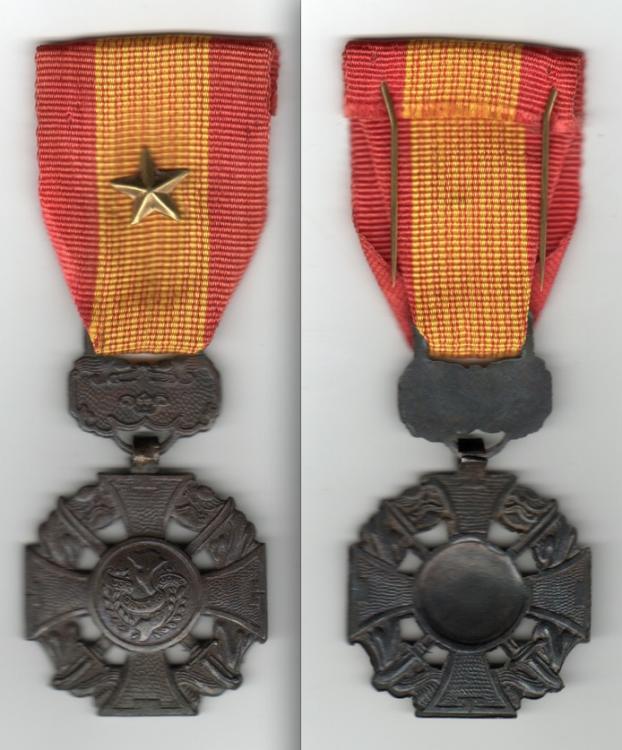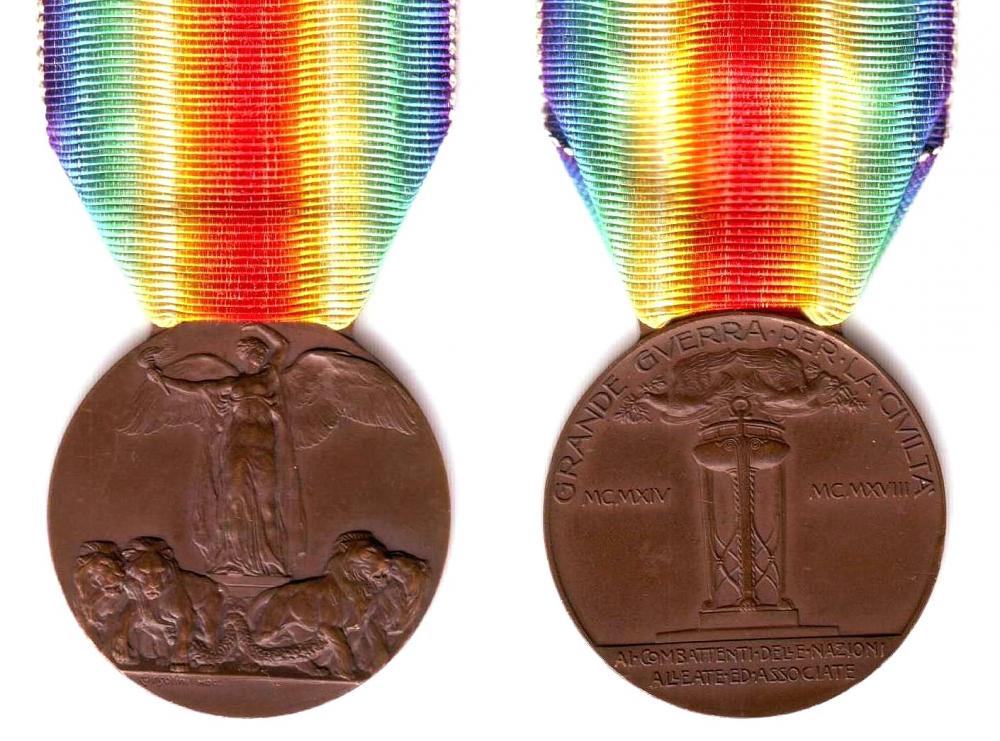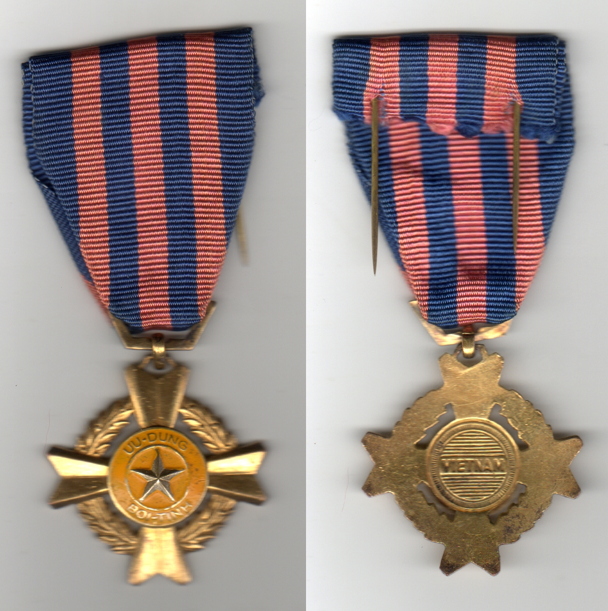-
Posts
1,169 -
Joined
-
Last visited
-
Days Won
1
Content Type
Profiles
Forums
Blogs
Gallery
Events
Store
Everything posted by RobW
-
-
-
To all the RVN collectors, In the Medals of America publication 'The Decorations and Medals of the Republic of Vietnam and Her Allies, 1950-1975', mention is made of a Unit Citation award of the Military Merit Medal. The wording on page 34 of that publication is: 'Unit Award (Huy-Hiệu Tuyên-Cộng Đơn-Vị). Apparently authorised circa 1974. Description: The ribbon is in a gold-frame with a leaf background'. Given the difficult security situation that RVN was in, circa 1974, it is possible that these awards were never made despite the apparent authorisation. Have any RVN collectors ever seen such a Military Merit Medal Unit Award and if so are there any pics available? Regards, Rob
-

Italian Victory Medals
RobW replied to Kev in Deva's topic in Inter-Allied Victory Medals of the Great War
Hello David, As far as a comparison picture is concerned, if you go back through this particular thread there are numerous pics of all the 4 common varieties. A specific composite picture is at post #15 with a close-up of the two different F.M. Lorioli-Castelli varieties at post #19. I have stopped posting my collection but there are numerous other illustrations in this thread which show the level of detail and differences between the varieties which can help you. Here is a pic of the official 'type 4' (This is not in my collection). Regards, Rob -
-

French Victory Medals
RobW replied to Kev in Deva's topic in Inter-Allied Victory Medals of the Great War
-
-
Hello all, Some further contributions to this thread. All items are local RVN manufactured versions. Army Meritorious Service Medal. Any comments welcome. Regards, Rob
-

Victory Medal Ribbons in General
RobW replied to Tim B's topic in Inter-Allied Victory Medals of the Great War
Hello Bill, I have a copy of the article in quesiton from the September 1998 Medal News issue. It recounts the same background information about the Interallied Victory Medal conference that is contained in the introdcution to Mr Alex Laslo's book, as it specifically relates to the discussion about how the design of the vic ribbon was chosen. Regards, Rob -

South African Victory Medals
RobW replied to JPL's topic in Inter-Allied Victory Medals of the Great War
Hi David, I picked up one of this interesting variety a couple of years ago. They are quite unique and there does not seem to be much information out there on their background. On my example the reverse planchet central area was particularly smooth, with what appeared to be grinding/filing marks just visible below the surface. That suggests the original lettering was removed, while the engraving looked professionally done. In addition there were, on my piece, a number of shallow test holes in the rim; which may have been indicative of some form of testing. What is noticeable on the example you linked to, was the barrel suspender does not appear to be part of the planchet with what appears to be solder, very noticeable, on the obverse. Regards, Rob -

Italian Victory Medals
RobW replied to Kev in Deva's topic in Inter-Allied Victory Medals of the Great War
Hello Claudio, I have also seen these initial victory medal authorisation documents glued onto the corresponding diploma for the Italian War Medal 1915-1918 (Medaglia Dell Guerra 1915-1918). There is, as you have suggested, great variety in these authorisation documents. Regards, Rob -
Hello Oliver, A nice darker patina Reimer model you have posted. It is great that you also post diameter and planchet thickness because that helps out all the vic collectors to see if there are differences to item in their collection. Regards, Rob
-
Hello David, Notwithstanding that you are out of pocket some money, I would probably keep it as an education opportunity. Having modern reproductions to review in hand is as probaly as good as having the genuine example. The sort of bronze coloured reproduction that is illustrated above are quite common an eminate from the UK. Most of the vic series have been so reproduced all in the same sort of base metal. In this particular example the reverse planchet die flaws are common across a range of Cuban reproductions so keeping one close by for reference is a good idea. Regards, Rob
-

Romanian Victory Medals
RobW replied to Kev in Deva's topic in Inter-Allied Victory Medals of the Great War
Hello Oliver, A good selection that you have posted here on the forum for the benefit of all the fellow vic collectors. The range of minor variations, especially noted on the Romanian vic, is attributable to a wide and un-documented number of local unofficial manufacturers. It is this large number of variations that makes the vics worth collecting, as you never really finish collecting. It is, however, a long and often slippery slope once you start trying to find all the different major and then minor variations. Thanks for posting these pictures. Regards, Rob -

American (US) Victory Medals
RobW replied to Kev in Deva's topic in Inter-Allied Victory Medals of the Great War
Hello Herman, I would leave both the brooch and engagment clasps as they are, unless you want to specifically construct a US french-made example complete with clasps. As Bill has indicated the edge marking of the large font 'MADE IN FRANCE' is consistent with late 20's to early 30's french manufacture; as is the ribbed planchet edges. Once the specimen is in your hands I would also inspect the remainder of the rim for either the marking 'BRONZE' or some other makers mark. You will also want to inspect both sides of the large suspension ring as there are occasionally markings on that as well. A gentle brush, with some warm water and a soft toothbrush, will remove the crud that has accumulated on the top section of the planchet reverse. A nice example. Regards, Rob -

Thai/Siamese Victory Medals
RobW replied to RobW's topic in Inter-Allied Victory Medals of the Great War
Hello david, A nice example that you have waited patiently for. Sometimes the rarer examples are worth the wait. I would replace the current ribbon (as it is a latter US type) and replace it with some nice French made ribbon. That would make your example more correct to type. Regards, Rob -

French reproduction British Victory medal
RobW replied to RobW's topic in Great Britain: Orders, Gallantry, Campaign Medals
Tony, The planchet of my British medal, both obverse and reverse, appears the same as the official strike which leads me to believe it was a British production. The only difference on the planchet is the lack of the small plinth beneath the barrel suspender; which, as you know is part of the planchet striking. In this case the planchet is completely circular with the ball suspender soldered on top in place of the barrel suspender. The entire production has the same shiny gilt finish as seen on the official strikes. The medal is named. The naming style and type is totally consistent with that seen on official strikes which leads me to conclude it was a later issue maybe as a replacement or a late claim. I don't think it was made for the collector market. The recipient is listed as: 24583 PTE J.P. CLARK. W.YORK. R. I have not conducted any research on PTE CLARK yet; nor do I yet have a copy of his MIC. That is a project for the future when I have the time. In regards the actual medal; due to a number of reasons I no longer post pictures of my collection on this forum; but I hope the explanation above is enough to satisfy your curiosity. Regards, Rob -

Romanian Victory Medals
RobW replied to Kev in Deva's topic in Inter-Allied Victory Medals of the Great War
Hello Percy, If you are new to this collecting area then I would suggest you obtain the second edition of Mr Alex Laslo's work on the vic series. It is available relatively cheaply on a myriad of online sites. That, combined with the pictures in this forum, should be of assistance. Regards, Rob -

South African Victory Medals
RobW replied to JPL's topic in Inter-Allied Victory Medals of the Great War
Hi Peter, The entire victory medal series has been faked for quite a few years now; more predominantly the harder to obtain pieces like the Siam vic. I suppose with a known international market for the vic series in general it will always be attractive to the fakers to make their wares and hope they snare the unsuspecting buyer. Luckily, in this instance, the style and type of naming lettering is too different to that seen on originals. I think one the more lasting benefits of places like this forum is to share the knowledge and good quality pictures as an aid to educate the new and inexperienced collectors. Regards, Rob -

French reproduction British Victory medal
RobW replied to RobW's topic in Great Britain: Orders, Gallantry, Campaign Medals
Hi Tony, The French firm of M. Delande produced all manner of medals from a variety of countries and it is quite standard for them to use the ball suspender. They have produced a version of a number of vics from other countries that awarded the medal, including the Siam, US, and Portugal vics that had a ball suspender. The 39-45 Star, illustrated above, is but one of many that were produced by M. Delande and these varieties are not seen that often. In regards the vic mini I have this one listed above at 15 mm as well as another at 12mm which are two of the standard sizes for French mini's. I also have a full-size British vic with a ball suspender but that specimen appears to be British made with the addition of a ball suspender. Regards, Rob -

Romanian Victory Medals
RobW replied to Kev in Deva's topic in Inter-Allied Victory Medals of the Great War
Hi Percy, Thanks for the extra photos. It clearly shows what I had assumed was a planchet error, to be a shadow from the camera. A nice example of the official strike. My apologies if my follow-up question gave you pause for thought. Regards, Rob -

South African Victory Medals
RobW replied to JPL's topic in Inter-Allied Victory Medals of the Great War
Hi David, To provide some specific guidance regarding the South African type 2. They are particularly difficult to find so if opportunity presents snag it because they just don't seem to be appearing on the market. There are comparison pics of relatively good quality at posts # 2 & #3 at the start of this sub-thread. If you also collect miniatures be aware that the bi-lingual vic is even rarer than the type 2 full-size. The vast majority of South African miniature groups have the standard British vic mini but there were also bi-lingual vic mini's produced but in very limited quantities. They are exceptionally rarely seen so again; should you see one snag it. I have a number of examples of the full-size type 2 in my collection, as well as a bi-lingual mini, but they are staying put for the foreseeable future. Good luck in your quest. Regards, Rob -

French Victory Medals
RobW replied to Kev in Deva's topic in Inter-Allied Victory Medals of the Great War
Hello Normandie, Un-marked Chobillon varieties like this are rarely seen without the BRONZE or 'AC'. I have a couple in my collection which have a more copper finish than a darker bronze as well as one that is in a Kretley Maison box. A good pick-up of a more difficult to obtain sub-variety of the Chobillon design. Regards, Rob -

Thai/Siamese Victory Medals
RobW replied to RobW's topic in Inter-Allied Victory Medals of the Great War
Hello Percy, To echo Tim's response; definitely not an official piece. I would suggest you copy one of the close-up pics of the obverse/reverse of the official Siam vic from this sub-thread and use that as a guide when attempting to locate an official example. Short of requesting additional pics from the vendor, you would be well placed to observe and confirm before parting with your money. The Brazil, Cuba and Siam pieces are becoming harder to obtain in good condition and prices never seem to go down. Have fun searching. Regards, Rob -

Italian Victory Medals
RobW replied to Kev in Deva's topic in Inter-Allied Victory Medals of the Great War
Hello David, Don't forget to try and obtain the variety that doesn't have a makers name. It is listed as the official type 4. It is harder to obtain than the other three but is out there in the marketplace. Regards, Rob






